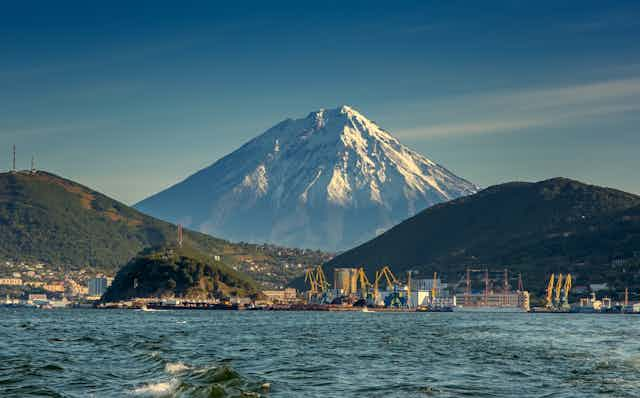Russian President, Vladimir Putin, has taken a trip to Russia’s untamed and isolated far east as part of a campaign to promote tourism in the region. This is the latest in a long list of largely unsuccessful attempts to regenerate the region that date back to the Soviet era.
Throughout this period, the area was dominated by the defence industry and was home to more than 300,000 troops defending the border with China. Vladivostok, the second-largest city in Russia’s far east, was also a closed port. Territories in the region have always been used as a cash cow by the regime due to their vast energy and mineral resources.
Mikhail Gorbachev, the last leader of the Soviet Union, tried to change this by transforming the far eastern territories into a “window on the Asia-Pacific”. He initiated a development plan that promoted regional cooperation with corresponding areas on the Chinese side of the border to promote trade.
Gorbachev was partially successful in demilitarising the region and began talks on border demarcation with China. But economic development was slow. And since the collapse of the Soviet Union in 1991, the territory has suffered a multitude of socioeconomic problems, including a low birth rate, high mortality rate, unemployment and outward migration.
Boris Yeltsin, the first President of the Russian Federation, and Dmitry Medvedev (president between 2008 and 2012) also announced similar plans. However, both ultimately failed to develop the region economically.

Putin has formulated various plans to develop the region too – the latest being through the promotion of tourism. But the fundamental focus on raw material production and the defence industry has persisted.
Opening up opportunity
For a while, Russia seemed to be making a concerted effort to fulfil Gorbachev’s vision. In 1998, it joined the Asia-Pacific Economic Corporation, a major multilateral organisation that was set up to drive trade liberalisation in the Asia-Pacific.
This initiative was part of Russia’s “pivot to the east”, which sought to reorient Russian foreign trade away from China towards countries like Japan and South Korea.
In 2012, Vladivostok even hosted the Asia-Pacific Economic Corporation summit – at the time billed as the high-point of Russia’s eastern pivot. But, while the summit showcased local development projects, it also revealed the extent of local corruption. Investigators estimated that 29 million rubles (US$889,000) were stolen from funds meant for the summit.
These attempts to diversify trade away from China were also partly political. Debates were ongoing among policymakers around the risks associated with an excessive reliance on China. One of the main concerns was that Russia might end up assuming a long-term role as a raw materials appendage to the rising power.
Dependent on China
This pivot has ultimately entrenched Russia’s strong relationship with China. In 2001, a year after Putin became president, a “flexible strategic partnership” was declared with China and relations have gathered pace since. In 2023, trade between the two countries hit a record high of US$240 billion.
Russia’s exports to China today are still marked by a substantial presence of energy and raw materials. And much of this is sourced from Russia’s far east. The primary exports from the region include oil and gas (constituting around 50% of exports), fish, timber and metals.
But the partnership between China and Russia has been limited in its ability to develop Russia’s far east. Despite being the major trading partner for several of Russia’s far eastern regions (and even the sole trading partner in some cases), China is not a big investor. Quite the contrary. Russia has long complained about the reluctance of China to invest in Russia’s far east.
But China has not invested for good reason. Russia’s far eastern territories are plagued by poor infrastructure, high labour costs and labyrinthine bureaucracy.
So, the government has attempted to tap into interest in tourism, not just from Russians wanting to undertake adventurous trips to the “wild east”, but also from Chinese tourists.
Wooing tourists
In 2019, Putin announced a law according to which only environmental tourism (visits that are of minimal environmental impact) can take place in nature reserves. Russia’s far east is known for its wild beauty and hosts 23 of these nature reserves.
The strategy also delineated plans for developing infrastructure for such tourism through the promotion of public-private partnerships. However, Russia’s far east is already grappling with issues such as overfishing, illegal logging and poaching of its wildlife (including by Chinese hunters from across the border). Mass unregulated tourism could exacerbate these problems.
Nonetheless, tourism will probably continue between the two countries. In February 2023, an agreement was reached between Russia and China for visa-free group tourist trips. And a bridge connecting Heihe (a city on the Chinese side of the border) with Blagoveshchensk on the Russian side has also been completed, making trips between the two countries easier.

It’s not only Chinese people from Heihe who will travel to Blagoveschensk. Tourists from other Chinese cities (and potentially even further afield) are attracted by fishing and hunting tours. The “Three Volcanoes” resort, for example, which is planned for construction in Kamchatka by 2025, had originally hoped to lure Japanese tourists with a promise of luxury and adventure.
But the war in Ukraine and the freezing of already lacklustre ties between Russia and Japan means Russia will need to rely on Chinese visitors and domestic tourism for the foreseeable future instead. Whether this new focus on tourism will deliver long-awaited development to the region remains to be seen.

